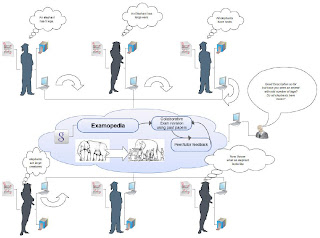I have been meaning to write this for quite some time now. To be honest, at some point in the run up to the ALT-C 2009 conference, I got this idea. There is a
shorter version of this post too. There were many people at a session titled "
the VLE is Dead" hosted by James Clay, Josie Frase, Graham Attwell, Nick Sharrat and Steve Wheeler aka Timbuckteeth :).
Martin Weller blogged about the death of
VLE/LMS too in Nov 2007. Scott Leislie coined a term
Loosely coupled teaching a month before that. Martin's prediction about a move towards loosely coupled teaching tools has examples in practice today. However, there is more to it. Let me exaplain
PLE...a set of tools that the learners enjoy full control on and choice of. The tools within a PLE are most likely not used for the purpose of formal education of all learners within an educational institution. Each learner may use a different set of tools to support/enhance their informal learning.
VLE...a set of tools that the learners enjoy very little control over, if any, or choice of and is an institutional system that is mostly likely for formal education. Academics and the institutions have the most control on this learning environment. Learners may have a say in it to some extent.
Loosely coupled.....to quote Scott, "course taught using contemporary social software/web 2.0 tools outside a course management system." - again these tools the learner may have little control over but the academic is the owner and has most control/choice. As its non institutional learning environment, it is most likely to support informal teaching and learning but may be used for formal teaching and learning too. I have blogged on this type of tools as my own
personal teaching environment.
CLE or Cloud Learning Environment....The cloud can be seen as one big autonomous system not owned by any educational institution. Let the Academics or Learners be the users, of some cloud based services, who all equally share the privelages like control, choice, sharing of content etc on these services. Then this is different from a PLE, a VLE and a PTE. For example Google Apps for universities is hosted on the cloud, not fully controlled by any educational institution and certainly not owned by one. The tools on it are to a great extent academic or learner controlled. Each "Google Site", for example, can be owned by an academic or a Learner and both users be given the same rights/control by one another (depending on who creates first). Likewise Google Docs can be owned and shared between learners themselves or learners and academics under their own control.
This gives all parties the same rights on same set of tools. This clearly has potential to enable and facilitate both formal and informal learning for the learner. Both the academic and the learner are free to use the tools the way they wanted and share and collaborate with anyone they wanted. This would not have been possible if either the academics or the learners or for that matter the institution designed and developed the set of tools or bought it from any one supplier. Google Apps was not designed just for institutions or for individuals, it was designed for collaboration both within and accross institutions.
CLEs also makes it very easy to generate content and share it with the rest of the world in a DERPable (Discoverable, Editable, Repurposable and Portable) manner, in the spirit of the UKOER programme. With a bit of search engine optimisation it could work magic in terms of making the educational material that sits on a CLE visible and usable by the rest of the world.
Lastly, students at my institution love the Google Apps interface, which makes it very easy to get them to engage with their work using online tools. This can be seen from the crazy
usage statistics of
Google Sites where I now host my
Examopedia.


